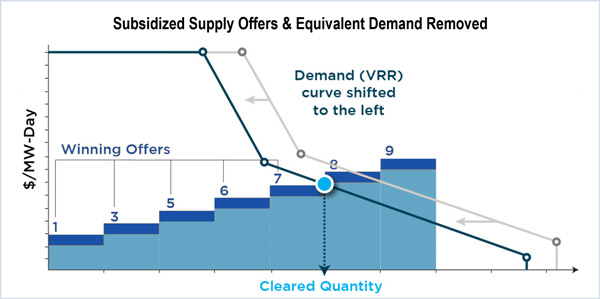By Rory D. Sweeney
For some time, PJM has found itself in a no-win situation, pitting stakeholders valuing market consistency against those seeking flexibility to integrate changing ideas and technologies.
From technological advancements that have reduced demand, to the shale gas boom that has upended the supply stack, to governmental actions that have artificially buoyed preferred technologies, what’s an RTO to do?
“Increasingly, public policies seek to recognize value associated with generation plants beyond their cost effectiveness and reliability attributes,” PJM said in an explanatory document released last week. “The most recent iteration of state policies has involved explicit, legislatively driven subsidies for specific generating units. These types of subsidies can suppress wholesale electricity market prices and threaten these markets’ basic design mission.”
But through that document and three supporting papers, PJM believes it has found a way forward. The RTO published the document along with the last two of three working papers that each focus on addressing different aspects of the issue.
The first, published the same day as a May FERC technical conference analyzing the viability of energy markets, offered guidelines for how states could work with PJM to develop carbon pricing rules that integrate with existing market structures. (See PJM Stakeholders Offer Different Takes on Markets’ Viability.)
The second, published last week as an update of a proposal PJM floated last year, outlines a two-phase capacity auction that would allow subsidized resources to be counted as available reserves without influencing the clearing price. (See PJM’s Grid 20/20 Ponders Mixing Public Policy, Competitive Markets.)
Also published last week was a third paper containing ideas initially advanced in PJM’s response to its Independent Market Monitor’s 2016 State of the Market report. In it, the RTO proposes tweaks to its energy market design to address complaints that market factors — both naturally developing and artificially introduced — have improperly depressed clearing prices so that true real-time costs aren’t being accurately reflected. The grid operator argues that its price-setting logic should be revised to allow inflexible units to set LMPs. (See PJM Differs with Monitor in State of the Market Response.)
“Since the inception of competitive wholesale electricity markets, the industry has evolved significantly and in ways that could not have been fully anticipated,” the document said. “Technological disruptions … have altered the economics of electricity supply, creating new opportunities and challenges. … These shifts in economic trends and market dynamics could lead to an unintended bias in the energy markets favoring lower capital cost resources … [putting] financial stress on all units, but particularly large units with high capital costs.”
The proposals face an uphill battle for acceptance. Stakeholders have criticized PJM for filing some of the ideas with FERC as additional testimony during the technical conference. The Monitor opposes the proposed changes to the LMP-setting logic.
Market participants have also expressed concerns with the RTO’s two-phase capacity-auction proposal. And carbon pricing was a tough sell long before President Trump set out to eliminate his predecessor’s signature Clean Power Plan. (See Trump Order Begins Perilous Attempt to Undo Clean Power Plan.)
PJM acknowledges the work ahead. The capacity proposal, it said, “likely will be evaluated with other potential solutions” by the Capacity Constructs/Public Policy Senior Task Force, which has been meeting regularly since January and remains mired in foundational discussions on the basic goals of a capacity construct. (See PJM Capacity Task Force Debates the Value of Price Transparency.)
The other proposals haven’t found a home for discussion yet, but the RTO is confident something must be done.
“I certainly think a do-nothing approach going forward puts the goals of the markets in general at risk,” Stu Bresler, PJM’s senior vice president of operations and markets, said at PJM’s Grid 20/20 conference on the issue last August. “The risk of a do-nothing approach is a detrimental effect on the long-term price signal.”





